Choosing the right polyamide feels like navigating a maze. Pick the wrong one, and you risk part failure, budget overruns, and project delays. This guide breaks down the key differences, ensuring you select the perfect material for your specific needs and achieve success from the start.
The best polyamide depends entirely on your application’s demands. PA6 and PA66 offer high strength and stiffness for mechanical parts. PA12 provides excellent flexibility and low moisture absorption for tubing or parts in humid environments. PA1010 is a bio-based option that balances good performance with sustainability, ideal for eco-conscious products.
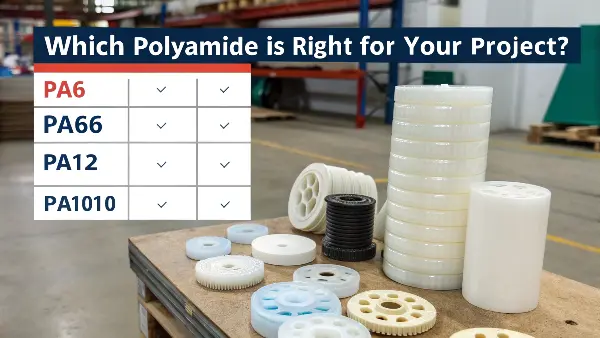
These materials might seem similar on a datasheet, but their real-world performance can vary dramatically. As someone who has managed countless molding projects, I’ve seen firsthand how a small difference in material choice can make or break a product. The key is to look beyond the surface-level numbers and understand how properties like moisture absorption, temperature resistance, and processability will impact your final part. Let’s dive deeper into what sets these materials apart so you can make an informed decision with confidence.
How Do the Mechanical Strengths of PA6, PA66, PA12, and PA1010 Compare?
You need your component to be strong and reliable under stress. But choosing a material that is too brittle or not stiff enough can lead to catastrophic failures in the field, damaging your product’s reputation and costing a fortune in recalls. Let’s compare their core mechanical profiles.
PA66 is generally the strongest and stiffest of the group, making it ideal for high-load applications. PA6 follows closely behind, offering a great balance of toughness and strength. PA12 is the most flexible and has superior impact resistance, especially at low temperatures. PA1010 provides good ductility and toughness, performing reliably across various conditions.
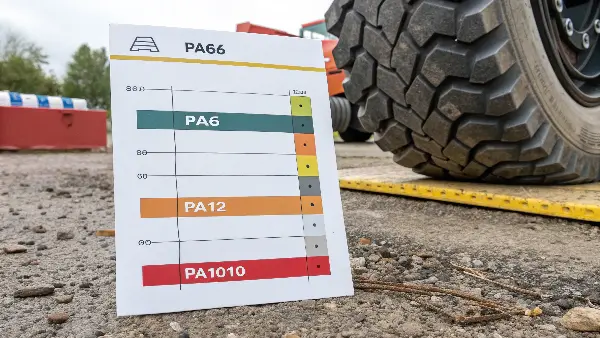
The difference in mechanical properties comes down to their molecular structure. At CAVITYMOLD, we always start by asking our clients about the specific loads and stresses a part will face. This is because the distinction between, say, PA6 and PA66 can be critical.
Understanding the Structural Differences
PA66 has a more tightly packed and symmetrical crystalline structure compared to PA6. This is why it exhibits slightly higher tensile strength and a better modulus. It’s my go-to recommendation for things like small, high-stress gears or load-bearing brackets where minimal flex is a requirement. PA6, while a fantastic all-rounder, has a bit more toughness, making it more forgiving for parts that might experience sudden impacts, like power tool housings.
PA12 and PA1010 are in a different class. Their longer polymer chains result in lower density and much greater flexibility. PA12 is exceptionally tough, even in freezing conditions, which is why it’s so common in automotive fuel lines and air brake tubing that must perform in all weather. PA1010, derived from castor oil, offers a unique profile. It’s not as stiff as PA66 but provides excellent ductility and fatigue resistance, making it perfect for applications like high-performance sports equipment or sunglass frames that need to bend without breaking.
Here’s a simplified comparison table to visualize the differences:
| Property | PA6 | PA66 | PA12 | PA1010 |
|---|---|---|---|---|
| Tensile Strength | High | Very High | Medium | Medium-High |
| Stiffness (Flex Modulus) | High | Very High | Low | Medium |
| Impact Strength | Good | Good | Excellent | Very Good |
| Hardness | High | Very High | Medium | Medium |
I remember a project involving an industrial clamp. The initial design used PA6, but field tests showed it was deforming slightly under maximum load. We switched the material to PA66, and with no design changes, the exact same part held perfectly. It’s these subtle but crucial differences that determine a project’s success.
How Does Water Absorption Impact These Polyamides in Real-World Use?
You’ve designed a part with precision-fit components and tight tolerances. But after a few weeks in a humid environment, the part has swollen, warped, and no longer functions correctly, jeopardizing the entire assembly. This is the hidden danger of moisture absorption in some plastics.
PA6 and PA66 absorb significant amounts of moisture from the air, which can alter their dimensions and mechanical properties. In contrast, PA12 and PA1010 absorb very little water, making them dimensionally stable and a much safer choice for applications in wet or humid conditions or those requiring tight tolerances.
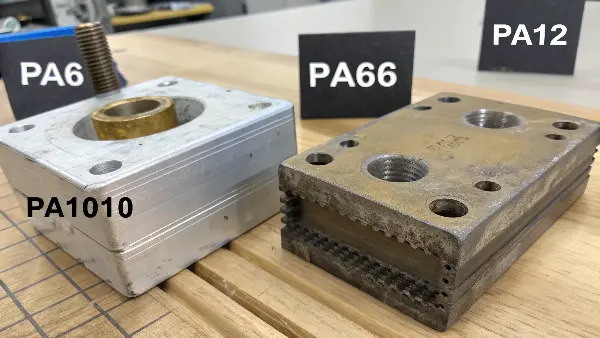
This is one of the most critical factors I discuss with clients. Forgetting to account for moisture absorption is a common and costly mistake. When a polyamide like PA6 or PA66 absorbs water, the H2O molecules act as a plasticizer. This means the material becomes less stiff and more ductile, but it also swells in size. If your part needs to maintain its exact dimensions to function, this can be a disaster.
Dimensional Stability is Key
Think about electrical connectors. They rely on precise spacing to prevent short circuits. If you use PA66 for a connector housing in a tropical climate, it could swell over time, compromising its insulating properties. In this scenario, PA12 would be a far superior choice. Its low moisture uptake ensures that it stays the same size and shape regardless of the ambient humidity.
This principle applies to any assembly with moving parts or tight fits. A few years ago, a client came to us with a problem. They had designed a fluid metering device using PA6, and the internal components were binding up after a short time in service. We investigated and found that moisture absorption was causing the parts to swell by nearly 2%. We remade the mold and the parts using PA12, and the problem was completely solved.
Here’s how they stack up:
| Polyamide Type | Moisture Absorption (23°C / 50% RH) | Impact on Properties |
|---|---|---|
| PA6 | ~3.0% | Significant swelling; decreased stiffness, increased impact strength. |
| PA66 | ~2.5% | Noticeable swelling; decreased stiffness, increased impact strength. |
| PA12 | ~0.5% | Negligible swelling; properties remain very stable. |
| PA1010 | ~0.6% | Very low swelling; properties remain stable. |
When is Moisture Absorption Okay?
Sometimes, the effects of moisture absorption can be acceptable or even beneficial. For a simple snap-fit enclosure, the increased flexibility from absorbed moisture can actually make the clips more durable and less likely to break. However, you must account for this in the design stage. If you decide to use PA6 or PA66, the part needs to be designed with tolerances that can accommodate the expected dimensional change. For critical applications, conditioning the parts to their expected moisture level before assembly is a common practice.
What Are the Best Industrial Applications for Each Polyamide?
You have a product idea, but you’re not sure which material fits the job. Using a high-performance polyamide for a simple housing is overkill, but using a basic one for a high-stress gear will lead to failure. Matching the material to the application saves money and ensures performance.
PA6 is an all-purpose workhorse for automotive parts and consumer goods. PA66 is for high-stress, high-temperature parts like gears and bearings. PA12 excels in flexible tubing and applications needing chemical resistance. PA1010 is for eco-friendly products where durability and flexibility are still required.
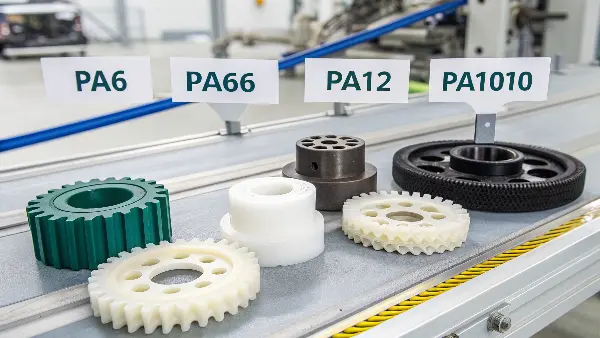
Over my career, I’ve seen these materials used in thousands of different products. The right choice often becomes clear when you focus on the primary requirement of the part. Let’s break down the common use cases for each material.
PA6: The Versatile Workhorse
Because of its excellent balance of strength, toughness, and cost-effectiveness, PA6 is everywhere. It’s a go-to for parts that need good mechanical durability but aren’t subjected to the absolute highest levels of stress or temperature.
- Automotive: Engine covers, radiator grilles, fan blades.
- Consumer Goods: Power tool housings, office chair components, luggage wheels.
- Industrial: Casters, fittings, and general-purpose mechanical parts.
PA66: The High-Performance Champion
When you need maximum strength, stiffness, and heat resistance, PA66 is the answer. Its superior mechanical properties under load make it the choice for more demanding applications where failure is not an option.
- Mechanical: High-load gears, bearings, bushings, and fasteners.
- Automotive: Air intake manifolds, rocker covers, and oil pans where it sees high temperatures.
- Electrical: Insulators, terminal blocks, and connector housings that require high rigidity.
PA12: The Flexible and Stable Specialist
PA12’s unique combination of flexibility, chemical resistance, and low moisture absorption carves out a niche for it in specialized applications. It’s the material you choose when environmental stability is paramount.
- Tubing and Hoses: Automotive fuel lines, pneumatic tubes, and hydraulic hoses.
- Coatings: Metal cable and wire sheathing for excellent abrasion and chemical protection.
- Precision Parts: Watch components, medical devices, and fine-pitch connectors that demand dimensional stability.
PA1010: The Sustainable Performer
As more companies prioritize sustainability, PA1010 is gaining traction. Derived from castor beans, it offers a lower carbon footprint than its petroleum-based counterparts while still delivering excellent performance.
- Consumer Goods: Premium sunglass frames, smartphone cases, and flexible watch bands.
- Sports Equipment: Components in running shoes, bindings, and protective gear.
- Industrial: Bio-based tubing for fluid transport and cable jacketing where a "green" material is desired.
Choosing correctly means you get the performance you need without overpaying for properties you don’t. We often help clients realize they can use PA6 instead of PA66 for a cost saving, or advise them to upgrade to PA12 for a critical part that must not fail due to moisture.
What Do Molders Need to Know When Processing PA6, PA66, PA12, and PA1010?
You have the perfect material, but your molder is struggling. Parts are coming out warped, brittle, or with surface defects. Improper processing can ruin even the best material choice, wasting time and money and delaying your project schedule. Understanding the basics is crucial for success.
All polyamides must be dried meticulously before injection molding to prevent degradation. PA6 and PA66 require higher melt and mold temperatures than PA12 and PA1010. PA66, in particular, has a narrow processing window that demands very precise temperature control to achieve optimal part properties.
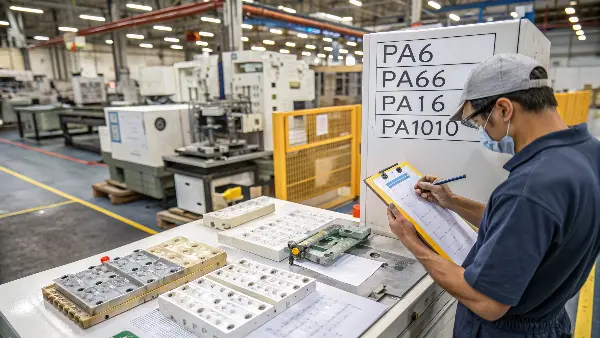
At CAVITYMOLD, this is our area of expertise. A great part is the result of a great mold and precise process control. Polyamides are wonderful materials, but they are very sensitive to how they are handled, especially regarding moisture and temperature.
The Non-Negotiable: Drying
This is the most critical step. Polyamides are hygroscopic, meaning they absorb water from the air. If you try to melt wet pellets, the water turns to steam and triggers a chemical reaction called hydrolysis. This breaks down the polymer chains, severely weakening the material and making your final part brittle. We always dry polyamide resins for at least 4 hours at around 80-90°C (175-195°F) in a desiccant dryer before they go anywhere near the molding machine.
Temperature Control is Everything
Each polyamide has its own ideal temperature profile. Using the wrong temperature can lead to a host of problems, from poor filling of the mold to thermal degradation of the material.
- PA6 & PA66: These have high melting points. They require melt temperatures of 240-280°C (465-535°F) and hot molds (80-120°C / 175-250°F). A hot mold is essential for achieving good crystallinity, which is what gives these materials their strength and stiffness. PA66 is especially tricky because its processing window is very narrow. A few degrees too high or too low can ruin the part.
- PA12 & PA1010: These materials have lower melting points and can be processed at cooler temperatures. Melt temperatures are typically in the 220-260°C (430-500°F) range, and mold temperatures can be lower, around 50-80°C (120-175°F). This makes them a bit easier to process.
Here is a general processing guide:
| Parameter | PA6 | PA66 | PA12 | PA1010 |
|---|---|---|---|---|
| Drying Time (hours) | 4-6 | 4-6 | 3-4 | 3-4 |
| Drying Temp (°C) | 80-90 | 80-90 | 80-100 | 80-90 |
| Melt Temp (°C) | 240-280 | 260-290 | 230-280 | 220-250 |
| Mold Temp (°C) | 80-120 | 80-120 | 50-80 | 60-90 |
| Shrinkage (%) | 0.8 – 1.5 | 0.8 – 1.5 | 1.0 – 2.0 | 1.0 – 1.8 |
Shrinkage is another key factor in mold design. We design our molds with precise cooling channels to manage the cooling rate, which helps control shrinkage and prevent warpage, ensuring the final part meets its specifications.
Conclusion
Choosing between PA6, PA66, PA12, and PA1010 isn’t about finding the "best" material, but the "right" one. It requires a careful balance of mechanical performance, environmental stability, and processing considerations. By understanding these key differences, you can select the ideal polyamide for your project’s success.
